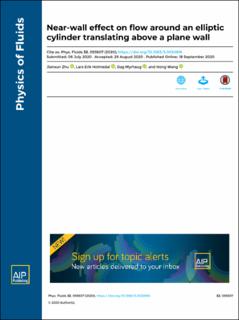Near-wall effect on flow around an elliptic cylinder translating above a plane wall
Peer reviewed, Journal article
Published version

View/
Date
2020Metadata
Show full item recordCollections
- Institutt for marin teknikk [3397]
- Publikasjoner fra CRIStin - NTNU [37177]
Original version
10.1063/5.0020818Abstract
In this work, the flow over an elliptic cylinder near a moving wall is investigated for Reynolds numbers less than 150. Here, the ratio between the gap (i.e., the distance between the cylinder and the wall) and the length of the semi-major axis of the elliptic cylinder varies from 0.1 to 5. This ratio is hereafter denoted as the gap ratio. The resulting Kármán vortex street, the two-layered wake, and the secondary vortex street have been investigated and visualized. Numerical simulations show that for the steady flow, the wake is composed of two asymmetric recirculation vortices, while a decrease in the gap ratio suppresses the vortex shed from the lower part of the cylinder. For the unsteady flow, the wake can be classified into four different patterns based on the wake structures (the Kármán vortex street, the two-layered wake, and the secondary vortex street). The regions of these wake patterns are given in the gap ratio and Reynolds number space, showing that the critical Reynolds number for the transition between different patterns increases as the gap ratio decreases. An overall increase in the mean drag coefficient with increasing gap ratios is observed, except for a sudden drop that occurs within a small gap ratio range. Moreover, as the gap ratio increases, the onset location of the two-layered wake first decreases due to a decrease in flow velocity in the gap and then increases due to the weakening of the wall suppression effect.